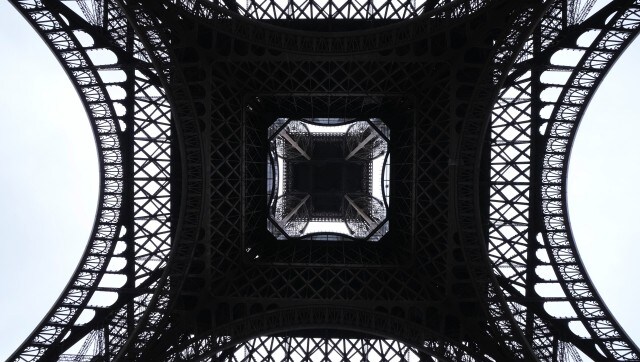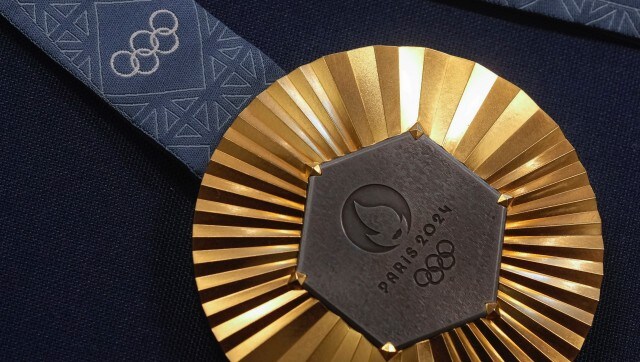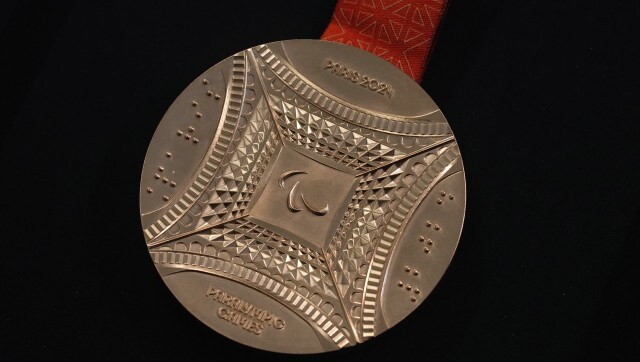
A hexagonal, polished piece of iron taken from the Eiffel Tower is being embedded in each gold, silver and bronze medal that will be hung around athletes' necks at the Paris Olympics and Paralympics. AP

A hexagonal, polished piece of iron taken from the Eiffel Tower is being embedded in each gold, silver and bronze medal that will be hung around athletes' necks at the Paris Olympics and Paralympics. AP
American gymnast Simone Biles has seven medals from her two previous Olympics in Tokyo and Rio de Janeiro. NBA star LeBron James has two golds and one bronze from London, Beijing and Athens. But neither of those athletes nor any of the roughly 36,600 other medalists at 29 previous Summer Olympics stretching back to 1896 ever owned one something that the ones at Paris Games will get.
The medals that will be awarded to athletes at the upcoming Games were unveiled on 8 February at the headquarters of the Paris 2024 Organising Committee.
What puts Paris Olympic Games medals apart?
In keeping with the tradition, medals are gold, silver and bronze. However, an anomaly from the ones in the past will be that each will be adorned with a small piece of Paris and a symbol of the France: the Eiffel Tower.
Très ému de vous présenter les médailles des championnes et champions de Paris 2024 ! pic.twitter.com/vJUSejl8Ys
— Tony Estanguet – OLY (@TonyEstanguet) February 8, 2024
A hexagonal, polished chunk of iron taken from the iconic building is being embedded in each medal that will be hung around athletes’ necks during the Games scheduled for 26 July-11 August.
“The concept came after a few discussions. We realised that there’s one symbol known across the world, which is the Eiffel Tower,” said Head of Design at Paris Games organising committee Joachim Roncin. “We said to ourselves, ‘Hey, what if we approached the Eiffel Tower Operating Co. to see if it’s possible to get a bit of the Eiffel Tower to integrate into the medal?’”
Tony Estanguet, President of the Paris 2024 Organising Committee, explained: “There was a huge amount done to try to bring together these precious metals – gold, silver and bronze – with the most precious metal in the Eiffel Tower, the jewel in the French crown. So what’s specific about the 2024 medals is that meshing together, that fusion, that alloy…”
“What’s impactful for this year will be having a part of the original Eiffel Tower metal, the iron, in these various medals, and so this is what we wanted to do, to infuse all these 2024 athletes with that metal.”
Are these really Eiffel Tower chunks?

Yes. Engineer Gustave’s Eiffel Tower was built for the 1889 World’s Fair — which celebrated the 100th anniversary of the French Revolution — and intended to stand for 20 years. Instead, it has lived on. The 135-year-old tower has withstood wear and tear due to surgery from time to time and constant care.
The 330-meter (1,083m) tall tower is made up of 18,038 iron parts. The iron pieces embedded in the center of the Olympic medals each weigh 18 grams.
It’s really a bit of metal from the Eiffel Tower,” said Roncin.
How were the chunks prepared?

The chunks of metal were stripped of paint, polished and varnished.
They are stamped with “Paris 2024” and the Games logo — which looks like a flame or the face of a woman. The five Olympic rings are also stamped on the iron of the Olympic medals. The Paralympic logo of three swooshes, known as the Agitos, is stamped on the medals for 28 August-8 September event.
The iron pieces’ hexagonal form represents France. The French sometimes refer to their country as “L’Hexagone” — the hexagon — because of its shape.
Around the iron pieces are disks of gold, silver or bronze. They’re crinkled to reflect the light, making the medals shine. Games organisers say the metal is all recycled, not newly mined.
Are Paris Olympic medals unique?

Beijing Olympics, in 2008, set the trend with medals containing inlaid jade disks. But Paris is the only host city to include chunks of a famous monument.
“Having a gold medal is already something incredible. But we wanted to add this French touch and we thought that the Eiffel Tower would be this cherry on the top,” Roncin said.
“Having a piece of it is a piece of history.”
The ancient Greek goddess of victory, Nike, has featured on the Olympic medals’ other side since 1928. But Paris has also added a small representation of the Eiffel Tower on that side, in another break with tradition.
For the Paralympians, the other side of the medal shows a view of the Eiffel Tower as if looking upward from underneath. For visually impaired winners, “Paris 2024” is written in Braille and the edges have notches: one for gold, two for silver, three for bronze.
In Numbers

5,084 medals – The Paris Mint is manufacturing 5,084 medals – 2600 for the Olympics and 2400 for the Paralympics. It is likely more than the required number. Some will be stored in case medals need to reassigned. Some go to museums. Any other spares could be destroyed.
529 grams – The gold medals weigh 529 grams. The gold medal is made of silver and plated with 6 grams of gold.
525 grams – The silver medals weigh 525 grams.
455 grams – The bronze medals weigh 455 grams and are a copper, tin and zinc alloy
The medals are 85 millimeters across and 9.2 millimeters thick.
Join our Whatsapp channel to get the latest global news updates